 initiation of e-government was initiated by the introduction of Multimedia Super Corridor (MSC) in 1996. Using e-government, it will improve the accessibility and quality of interactions with citizens and businesses. Simultaneously, information flow and processed improved the quality of policy development and as well the coordination and enforcement.
initiation of e-government was initiated by the introduction of Multimedia Super Corridor (MSC) in 1996. Using e-government, it will improve the accessibility and quality of interactions with citizens and businesses. Simultaneously, information flow and processed improved the quality of policy development and as well the coordination and enforcement.The primary delivery models of e-Government can be divided into:
- Government-to-Citizen or Government-to-Customer (G2C)
- Government-to-Business (G2B)
- Government-to-Government (G2G)
- Government-to-Employees (G2E)
Now everyone can conduct transactions without going through queuing, traffic jams or any bureaucratic hassles as they can conduct transactions at their own wish and convenience through various convenient channels such as eServices kiosk and Internet. Examples of e-services includes Tenaga Nasional Berhad (TNB) and Telekom Nasional Berhad (TM).
Electronic Labor Exchange (ELX)
 ELX is a one stop-centre for labor market information that supervised by Ministry of Human Resource (MORH) that enables employer and job seekers to communicate at the same platform with the objectives of:
ELX is a one stop-centre for labor market information that supervised by Ministry of Human Resource (MORH) that enables employer and job seekers to communicate at the same platform with the objectives of:- Enabled an effective and integrated job matching process
- Provide an effective center of labor market information and references
- To improve mobilization of the nation's human resources and to ensure the manpower utilization is optimized.
1) E-procurement
E-procurement system enables suppliers to sell goods and services to the Government through Internet. Suppliers advertise their pricing, process orders and deliveries. The objectives includes:
- Enables accountability and transparency
- Creates more skilled and knowledgeable workforce
- Equips the workforce with the latest technology at minimum cost
1) Human Resource Management Information System (HRMIS)
HRMIS is integrated for the Malaysian Public Service , incorporating Global Best Practices in HR that allows Public service successfully deal with with the challenges of the K-Economy. The objectives are:
- Effective Staffing and right-sizing of civil service
- Improve paperless HRM capabilities
- Open and flexible system
- Automated human resource managerial and operational processes
Government should increase the awareness and gain as much attention as possible from the citizens for the services provided in e-government. A higher level of customer satisfaction will increase the rate of e-government adoption which moving the same way with the government. Satisfaction can obtained by providing a better protected privacy and confidentiality of the user's information.
Other than that, to retain a long-term users to use e-government frequently, service quality should be competitive with the other developed country in terms of speed, problem serving approach and ease of use of the website.
Lastly, e-government must be advertised through suitable medium such as radio or television. workshop can be held to create awareness on the existence of e-government as this services provides problem solving as they are all full-focus in providing the best services to its citizens.
More information:
1) http://www.intanbk.intan.my/psimr/articles/Article1%20-%20Full.pdf
2) http://web.worldbank.org/WBSITE/EXTERNAL/TOPICS/EXTINFORMATIONANDCOMMUNICATIONANDTECHNOLOGIES/EXTEGOVERNMENT/0,,menuPK:702592~pagePK:149018~piPK:149093~theSitePK:702586,00.html
3) http://www.w3.org/2007/06/eGov-dc/papers/SecureEGovernmentPortals




 Here are some prevention steps in order to keep you out from credit card debt:
Here are some prevention steps in order to keep you out from credit card debt:




